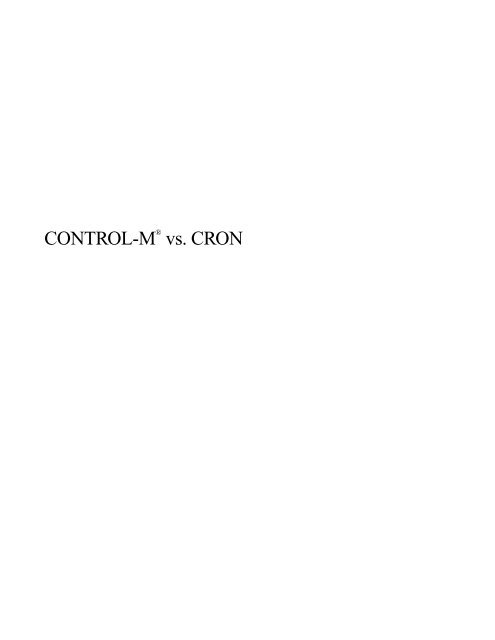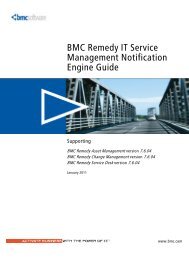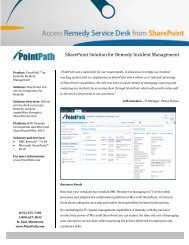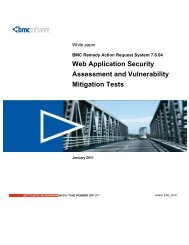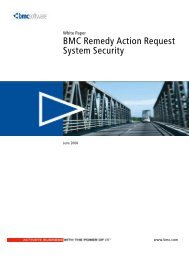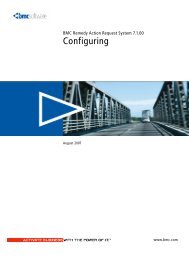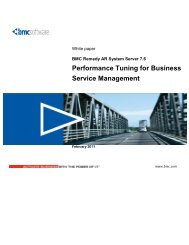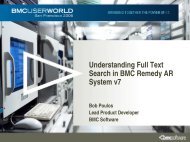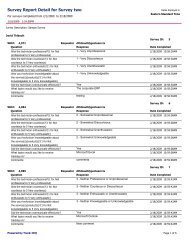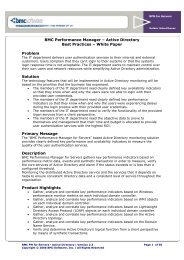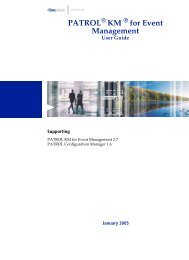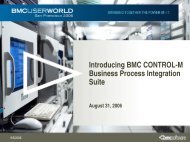CONTROL-M vs. CRON - BMC Communities - BMC Software
CONTROL-M vs. CRON - BMC Communities - BMC Software
CONTROL-M vs. CRON - BMC Communities - BMC Software
Create successful ePaper yourself
Turn your PDF publications into a flip-book with our unique Google optimized e-Paper software.
<strong>CONTROL</strong>-M ®<br />
<strong>vs</strong>. <strong>CRON</strong>
Contents<br />
Introduction.....................................................................................................1<br />
Architecture ....................................................................................................1<br />
Reliability, Availability and Scalability .........................................................3<br />
Focal Point of Control....................................................................................3<br />
Management-by-Exception............................................................................4<br />
Comprehensive Scheduling ..........................................................................5<br />
Open Load Balancing.....................................................................................6
Introduction<br />
Architecture<br />
<strong>CONTROL</strong>-M is <strong>BMC</strong> <strong>Software</strong>’s enterprise-wide management solution designed to<br />
automate heterogeneous production environments. As data center complexity grows,<br />
<strong>CONTROL</strong>-M consolidates and integrates the hardware and software networks across<br />
the organization.<br />
While <strong>CRON</strong> is only a built-in Unix-based scheduler, <strong>CONTROL</strong>-M provides<br />
comprehensive production management for the entire enterprise. <strong>CONTROL</strong>-M<br />
offers production control and scheduling capabilities across multiple platforms,<br />
including MVS, Unix, Microsoft Windows NT, VMS, OS/400, Tandem and OS/2.<br />
<strong>CONTROL</strong>-M is tightly integrated with ERP applications and frameworks. These<br />
applications can be efficiently integrated into the production environment. Users can<br />
manage application jobs without adding new tools or methods. <strong>CONTROL</strong>-M has<br />
certified interfaces to SAP R/3, Oracle Applications, Baan and PeopleSoft.<br />
<strong>CONTROL</strong>-M<br />
<strong>CONTROL</strong>-M provides a three-tier architecture to support configurations driven by<br />
business requirements, not technology limitations. This architecture provides the<br />
capability to control an unlimited number of systems, overcoming the constraints of<br />
managing a wide array of platforms, applications and interfaces. The three-tier<br />
architecture consists of Enterprise Controlstation ®<br />
, <strong>CONTROL</strong>-M/Servers and<br />
<strong>CONTROL</strong>-M/Agents.<br />
Enterprise Controlstation supplies a GUI offering a unified interface to all platforms, easily<br />
managing cross-platform dependencies. This consolidated view of scheduling<br />
information, active job information and exceptions enables control over the production<br />
environment. Thus, businesses eliminate the need for platform-specific experts and<br />
cross-training.<br />
<strong>CONTROL</strong>-M/Server is a full-function scheduler available on over 20 platforms. Each<br />
<strong>CONTROL</strong>-M/Server maintains its own database containing the relevant scheduling<br />
information for all agents connected to the <strong>CONTROL</strong>-M/Server. The information from<br />
the servers is communicated to the Enterprise Controlstation for inclusion in the consolidated<br />
view.<br />
Page 1
<strong>CONTROL</strong>-M is part of a three-tier architecture that supports configurations driven by business requirements, not<br />
technology limitations.<br />
Page 2<br />
<strong>CONTROL</strong>-M/Agents are managed by a <strong>CONTROL</strong>-M/Server. These<br />
<strong>CONTROL</strong>-M/Agents provide job submission, tracking and result analysis.<br />
Thus, <strong>CONTROL</strong>-M/Agents eliminate the need for a local database and additional<br />
administration, since scheduling decisions are made by the <strong>CONTROL</strong>-M/Server<br />
and transferred to the agent for execution.<br />
<strong>CRON</strong><br />
<strong>CRON</strong> is a single-tier scheduler that operates on Unix machines. The use of single-tier<br />
technology guarantees high availability, since each exceptional situation affects only<br />
the system experiencing the problem. Neither the network nor another system has to<br />
run the schedule on any specific machine.<br />
The downside of this system is that dependencies spanning more than one box cannot<br />
be managed by the <strong>CRON</strong> scheduling tool, since each box is operating as a stand-alone<br />
system. When an application requires a dependency, an external mechanism must be<br />
used. Such mechanisms are usually developed and maintained by the user. Therefore,<br />
the results of single-tier architecture are high administrative overhead and reduced system<br />
reliability.<br />
Additionally, with single-tier products there is no way to view and monitor the entire<br />
environment. A box is stand-alone, and the user must log on to each box to determine<br />
its schedule status.
Reliability, Availability and Scalability<br />
<strong>CONTROL</strong>-M<br />
Enterprise Controlstation and <strong>CONTROL</strong>-M offer a reliable and productive real-time<br />
environment where users can monitor the entire network. The Enterprise Controlstation<br />
GUI displays comprehensive data from every <strong>CONTROL</strong>-M/Server, eliminating the<br />
need to track production events manually.<br />
Enterprise Controlstation and <strong>CONTROL</strong>-M/Server communicate through gateway<br />
software. Therefore, in cases of communication failure, both the <strong>CONTROL</strong>-M and<br />
the Enterprise Controlstation database continue to gather information to guarantee<br />
data integrity. When communication is reestablished, the databases are automatically<br />
synchronized. Additionally, each <strong>CONTROL</strong>-M/Server contains fail-over capabilities<br />
to handle recovery in the event of problems.<br />
The <strong>CONTROL</strong>-M architecture enables growth and adaptation to changing environments.<br />
Flexible configurations are supported and components can reside on one or more physical<br />
hosts. This adaptability eliminates bottlenecks, ensuring optimal performance for highvolume<br />
workloads.<br />
<strong>CRON</strong><br />
Data integrity relies on the availability of the machine on which <strong>CRON</strong> is running. If the<br />
job definition files are corrupted, there is no easy method for recovery.<br />
Additionally, <strong>CRON</strong> has the following drawbacks:<br />
• The production scheduler must reside on each platform. Therefore, the configuration is<br />
not flexible.<br />
• Each new application must be added manually to every platform.<br />
• There is no central repository for the information existing on the platforms.<br />
• A box is stand-alone, and the user has to log on to each box to define and track jobs.<br />
Focal Point of Control<br />
<strong>CONTROL</strong>-M<br />
Enterprise Controlstation overcomes platform challenges while integrating the expertise<br />
of data center personnel and automated processes. The product automatically translates<br />
platform-specific data, making it unnecessary for data center users to handle<br />
this information manually.<br />
Page 3
Page 4<br />
The growing number of data center systems and platforms compounds the number of<br />
critical situations encountered. <strong>CONTROL</strong>-M meets the challenge of handling all adverse<br />
situations, scheduling modifications and execution bottlenecks.<br />
Enterprise Controlstation automates and unifies task relationships, error and problem<br />
correction, tracking and outcome verification. Businesses can then eliminate the cost and<br />
impact on productivity caused by training personnel on specific platforms. Additionally,<br />
the production workflow is not at risk when organizational changes occur or key personnel<br />
are absent.<br />
<strong>CRON</strong><br />
<strong>CRON</strong> is based on Unix command lines. It is therefore necessary to train specific staff<br />
members about the use of various Unix operating systems.<br />
Tasks and events on each platform have to be controlled and monitored individually.<br />
This is a very complicated job, especially when dealing with large environments. Since<br />
there are no common event-management tools, manual errors occur often and events<br />
are overlooked.<br />
In some cases, a front-end allows the user to switch between different windows displaying<br />
various systems. However, these front-ends are no more than “face lifts”; the user still has<br />
to move from window to window and does not receive a unified view of the entire production<br />
environment.<br />
Management-by-Exception<br />
<strong>CONTROL</strong>-M<br />
Enterprise Controlstation operates on the management-by-exception principle. The<br />
product has a unique user notification facility, the Alert window, which accumulates<br />
and displays SHOUT messages from each <strong>CONTROL</strong>-M installation. <strong>CONTROL</strong>-M<br />
can send these SHOUT messages to interactive users, SNMP traps and event<br />
management systems (such as PATROL ®<br />
by <strong>BMC</strong> <strong>Software</strong>).<br />
<strong>CRON</strong><br />
Users have to track jobs proactively, manually searching for exception events. To keep<br />
the production environment active at all times, much time and effort must be put into<br />
identifying and handling problems, making production slow and costly.
Comprehensive Scheduling<br />
<strong>CONTROL</strong>-M<br />
Common definition interface<br />
<strong>CONTROL</strong>-M’s single-definition facility uses point-and-click and drag-and-drop functions<br />
in combination with a flexible fill-in-the-blanks approach. Each task is defined using<br />
a single window. New definitions are easily created through a predefined outline. Several<br />
jobs can be defined according to the same outline, and mass updates can be used to change<br />
the relevant fields for several jobs in a single action. <strong>CONTROL</strong>-M provides a consistent<br />
task-definition process regardless of the platform.<br />
The Enterprise Controlstation Windows NT GUI allows users to intuitively create and<br />
maintain scheduling definitions. Dependencies can be drawn between relevant jobs.<br />
Additionally, global job updates and creations can be performed and the jobs are then<br />
arranged graphically. The Windows NT GUI allows users to view the job flow during<br />
the definition stage. It is therefore possible to eliminate loops and verify that the correct<br />
job flow has been created.<br />
Scheduling capabilities<br />
<strong>CONTROL</strong>-M can handle the most complex scheduling scenarios while reducing<br />
maintenance resulting from constant growth and changes in the production environment.<br />
Users can define scheduling references common to many tasks. For example, it is<br />
possible to define calendars that represent holidays or work periods for the organization.<br />
These calendars can then be used by several jobs.<br />
Dynamic parameter modification<br />
The <strong>CONTROL</strong>-M AutoEdit feature is an automatic setup facility that handles batch<br />
process modifications. The AutoEdit facility can handle even the most complex situations.<br />
The AutoEdit facility can perform tasks such as simple expression and calculation assignment,<br />
and comparison of values. Before <strong>CONTROL</strong>-M submits a task, the product analyzes<br />
and passes the resulting values to the AutoEdit script.<br />
External event management<br />
External events such as file events are coordinated using <strong>CONTROL</strong>-M tasks. Additionally,<br />
<strong>CONTROL</strong>-M provides full support for ad hoc tasks. When an unplanned task is<br />
to be submitted, the product manages the task in the same way that regularly scheduled<br />
tasks are managed.<br />
Page 5
Page 6<br />
Result processing<br />
<strong>CONTROL</strong>-M identifies and handles every combination of post-processing situations,<br />
including system crashes, security violations and execution errors. The product dynamically<br />
improves productivity by automatically detecting and managing all possible production<br />
situations as they occur.<br />
<strong>CRON</strong><br />
Job definitions in <strong>CRON</strong> require detailed knowledge of Unix in general and scripting<br />
specifically. Users must employ Unix editing tools (most commonly “vi”) to create job<br />
definitions.<br />
There is no graphical tool to view the job definitions. Therefore, the only way to be<br />
certain that the flow is correct is to submit a job definition and then correct the resulting<br />
errors. Each job is defined separately. When updates need to be made, only one job<br />
definition can be edited at a time.<br />
Since it is not possible to perform advanced error handling through <strong>CRON</strong>, users manually<br />
manipulate code in order to handle potential events. This causes a large amount of maintenance<br />
overhead.<br />
Open Load Balancing<br />
<strong>CONTROL</strong>-M<br />
Through the three-tier architecture and server/agent technology, <strong>CONTROL</strong>-M allows<br />
users to perform resource monitoring for agent platforms distributed across the network.<br />
<strong>CONTROL</strong>-M submits tasks to the agent platform with sufficient available resources to<br />
handle the execution. Thus, the product achieves optimum production throughput.<br />
By supplying monitoring and balancing tools, <strong>CONTROL</strong>-M prevents destructive<br />
execution bottlenecks. A task is released only when all required resources are available.<br />
This prevents resource queuing while allowing for application control. <strong>CONTROL</strong>-M<br />
improves overall system throughput by eliminating the need for manual resource management<br />
and control.<br />
<strong>CRON</strong><br />
<strong>CRON</strong> has a single-tier architecture. Therefore, each scheduler must reside on its own<br />
machine and contain its own database. Since there is no integration between the schedulers<br />
on the various machines, it is not possible to transfer jobs from one machine to the<br />
other, even if one machine has a heavy workload.
About <strong>BMC</strong> <strong>Software</strong><br />
<strong>BMC</strong> <strong>Software</strong> is the world’s leading provider of management solutions that ensure the<br />
availability, performance and recovery of companies’ business-critical applications. We<br />
call this application service assurance <br />
, and it means the applications you and your customers<br />
rely on most stay up and running around the clock. For more than 19 years, the<br />
world’s leading companies have relied on <strong>BMC</strong> <strong>Software</strong>.<br />
<strong>BMC</strong> <strong>Software</strong> is among the world’s largest independent software vendors, is a Forbes<br />
500 company and is a member of the S&P 500, with fiscal year 1999 revenues exceeding<br />
$1.3 billion. The company is headquartered in Houston, Texas, with offices worldwide.<br />
Page 7
For more information visit<br />
<strong>BMC</strong> <strong>Software</strong> on the Web at<br />
www.bmc.com<br />
<strong>BMC</strong> <strong>Software</strong>, the <strong>BMC</strong> <strong>Software</strong> logos and all<br />
other <strong>BMC</strong> <strong>Software</strong> product or service names are<br />
registered trademarks or trademarks of <strong>BMC</strong> <strong>Software</strong>,<br />
Inc. All other registered trademarks or trademarks<br />
belong to their respective companies.<br />
©2000 <strong>BMC</strong> <strong>Software</strong>, Inc. All rights reserved.<br />
100029105 1/00


